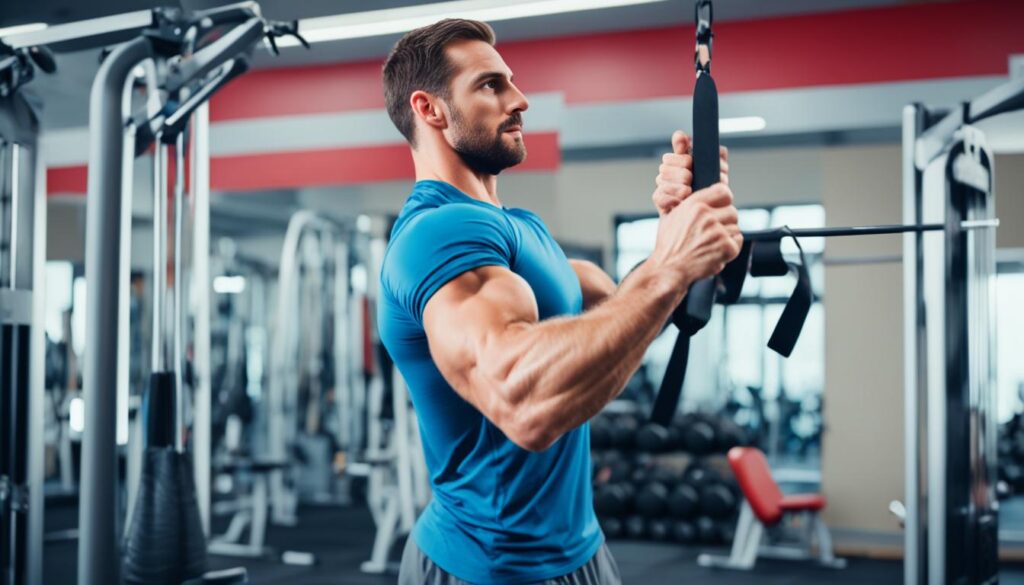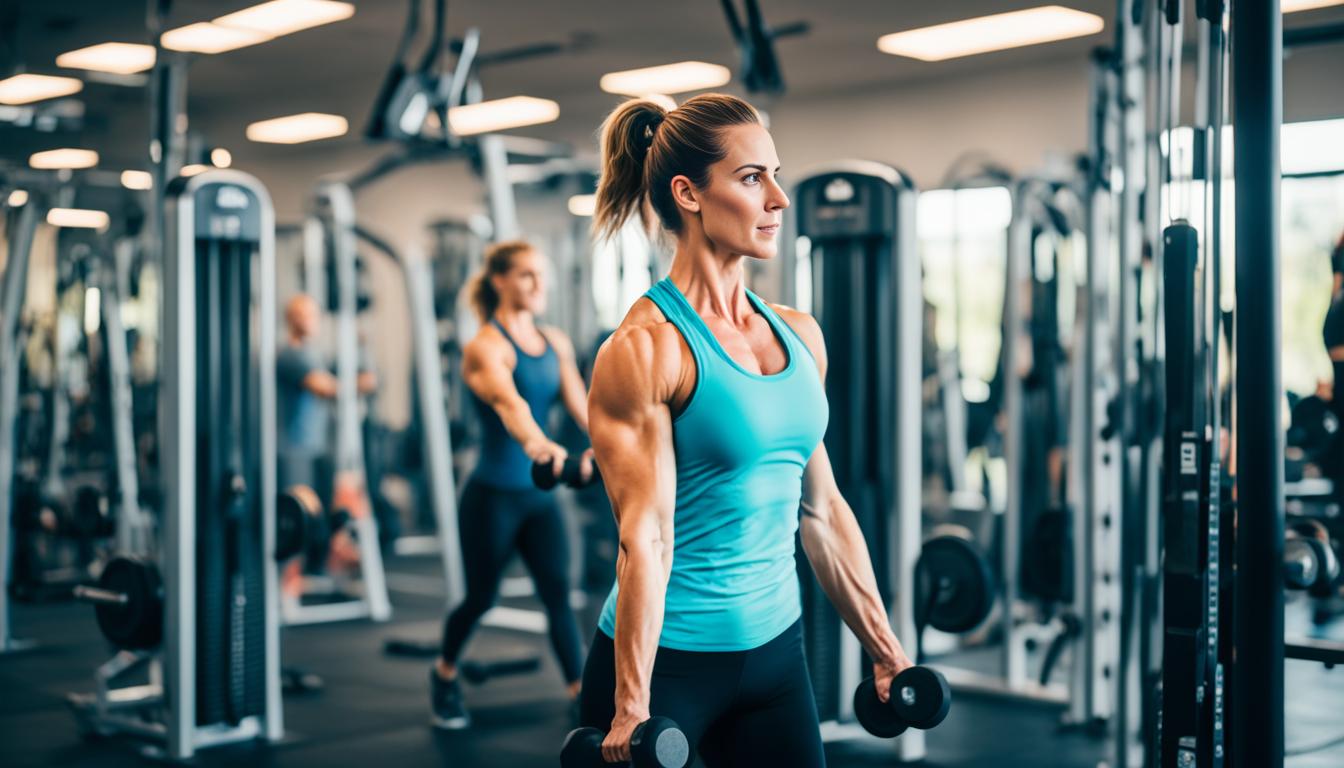Did you know 45% of adults prefer short, high-intensity workouts? In today’s busy life, fitting in a full workout can be tough. But, you don’t need hours for a good workout. Just 30 minutes of a well-planned routine can hit all major muscle groups and show results.
It doesn’t matter if you’re new to fitness or have been at it for years. Adding a muscle group workout to your busy life is smart and good for you. This routine makes sure every muscle gets the focus it needs. It helps with balanced strength and endurance.
Key Takeaways
- High-intensity, short-burst workouts are preferred by 45% of adults.
- Time-efficient workout plans can effectively target all major muscle groups.
- Beginners should consider starting with squats using an exercise ball for better form.
- Combining squats with an overhead press can efficiently engage multiple muscle groups.
- Performing this 30-minute workout routine every other day leads to optimal results.
For more tips and a full guide on starting high-intensity workouts, click here.
Introduction to the 30-Minute Full-Body Workout
This full-body exercise routine is perfect for those with busy lives but still want to see results. It’s a quick muscle workout that targets all major muscles in just 30 minutes. You’ll work on your chest, back, shoulders, arms, legs, and abs.

Benefits of High-Intensity Workouts
High-intensity workouts offer many benefits. They boost your metabolism and help tone your muscles. By moving quickly and dynamically, you burn calories and build muscle. This type of workout also improves your heart health and stamina.
Who Can Perform This Routine?
This full-body exercise routine suits intermediate to advanced levels, but beginners can join with some tweaks. If you’re new, start with one set of 10 to 12 reps. If you’re more experienced, go for two to three sets of 8 to 10 reps for better results.
You’ll need dumbbells, with women using 8 to 20 pounds and men using 15 to 35 pounds for rows. Begin with dynamic movements and bodyweight exercises to warm up safely. Aim to do this workout two to three times a week for the best outcomes.
- Three sets of 8 reps for dumbbell thrusters
- Three sets of 12 reps for dumbbell one-arm rows per arm
- Three sets of 10 reps for Romanian deadlifts
- 2 rounds of warm-up exercises – 5 minutes
- 45 seconds of dumbbell farmer’s carry in the cardio circuit
- 10 reps of burpees in the cardio circuit
- 20 reps of V-ups in the cardio circuit
Preparing for Your Workout: Warm-Up Strategies
Before starting a quick full body workout, it’s key to warm up properly. A good warm-up reduces muscle soreness and lowers injury risk. It makes your workout more successful and saves time.
Importance of a 5-Minute Warm-Up
A 5-minute warm-up boosts your workout performance. Dynamic stretching is best because it increases mobility and gets your nervous system ready. It activates muscles, which is vital for good muscle control and a strong connection between your mind and muscles.
Warming up also gets you mentally ready. It helps you focus and feel confident.

Research shows a good warm-up should include movements like those in your workout. For example, do some light cardio before a tough cardio session. This prepares your muscles well and lowers injury risk.
Simple Warm-Up Exercises
Here are easy exercises to add to your warm-up:
- Walking in Place: Walk in place for 60 seconds, gradually increasing your pace.
- Inchworm Exercise: Perform five repetitions by bending at your hips and walking your hands out to a plank position, then walking them back to your feet.
- Cat-Cow Stretches: Complete five repetitions to increase spinal mobility and engage your core muscles.
- Gate Openers: Execute five repetitions per side, lifting your knee and rotating it out to the side to activate the hip muscles.
Try to raise your heart rate by about 20 beats per minute to get your body ready for the workout. Don’t do static stretches during this time as they can lower performance and increase injury risk. Use foam rolling after your warm-up to improve blood flow and make muscles more flexible.
By using these warm-up strategies, you’ll be set for a great workout. You’ll work more efficiently and safely.
Lower Body Strengthening: Squats Overview
Squats are key in any muscle-building workout. They work on important muscles like the quadriceps, hamstrings, and glutes. This makes them vital for a strong lower body.
Proper Squat Technique
Proper squat technique is crucial for safety and effectiveness. Stand with your feet shoulder-width apart and toes a bit outwards. Keep your back straight and bend at the knees and hips.
Make sure your knees stay in line with your toes. Load management is also important. Start with lighter weights and gradually increase them.
For those looking to push harder, try adding touch-up sets with heavier weights. This can help increase strength.
Variations to Consider
Adding different squat variations can make your quick workout routine more challenging and varied. Some effective variations include:
- Bodyweight Squats: Great for beginners, focusing on proper form and muscle activation without extra weight.
- Barbell Back Squats: A full-body movement that targets the lower body, ideal for building muscle strength.
- Front Squats: Focuses on the quadriceps and engages the core.
- Overhead Squats: Works the upper body, promoting balanced strength.
For a thorough muscle-building workout, it’s crucial to hit all major muscles. Squats should be combined with exercises for the hamstrings and glutes for a balanced lower body routine.
Upper Body Power: Push-Ups for Chest and Shoulders
Push-ups are a key exercise that boosts upper body power. They work on the chest, shoulders, and triceps. This exercise is vital for a good workout plan, improving muscle endurance and strength.
Standard Push-Up Form
Getting the push-ups technique right is key for the best results and to avoid injuries. Here’s how to do a standard push-up:
- Start in a plank position with hands wider than shoulder-width apart and feet together.
- Keep your core tight and your body straight from head to heels.
- Bend your elbows to lower your body until your chest almost touches the floor.
- Push back up to the starting position by straightening your arms.
Beginners should start with 1 set of 12 to 16 reps. Those more experienced can do 1–3 sets of 8 to 12 reps. Always keep good form during each rep.
Modifying Push-Ups for Beginners
If standard push-ups are hard, there are easier versions to try:
- Knee Push-Ups: Do push-ups with knees on the ground to ease the load on your upper body.
- Incline Push-Ups: Use a bench or step to make it easier.
- Exercise Ball Push-Ups: Place hands on an exercise ball for better stability and core work.
When trying these easier versions, focus on proper technique to avoid injury and get the best results. Start with 1 set of 12 to 16 reps. Then, increase sets and reps as you get stronger.
| Experience Level | Recommended Sets | Repetitions |
|---|---|---|
| Beginner | 1 set | 12–16 reps |
| Intermediate | 1–3 sets | 8–12 reps |
| Advanced | 1–3 sets | 8–12 reps |
Push-ups are great for everyone, whether you’re new to fitness or a pro. They’re a key part of a efficient workout plan. Try to do this exercise 2 to 3 times a week. Make sure to rest for 48 hours between intense workouts for the best results.
Leg Day Essential: Lunges Explained
Lunges are key in leg day workouts. They strengthen the quads, hamstrings, and glutes in a simple way. This exercise targets major lower body muscles and helps fix muscle imbalances. Aim for 8 to 12 reps per set for best results.
How to Perform a Lunge Correctly
To do a lunge right, follow these steps:
- Stand upright with feet hip-width apart.
- Step forward with one leg, lowering your hips until both knees bend at about 90 degrees.
- Make sure the front knee is right over the ankle and the back knee just above the ground.
- Push back to the start and do the other leg.
Avoid mistakes like leaning forward, not engaging the core, and losing stability.
Weighted Lunge Variants
Adding weights to your lunges can make the exercise harder, boosting your 30-minute full body workout. You can use dumbbells, kettlebells, or a barbell. Here are some variations:
- Forward Lunges: Carry a weight in each hand as you step forward.
- Reverse Lunges: Step back instead for a different muscle focus.
- Side Lunges: Lunge to the side to work your inner and outer thighs.
- Curtsy Lunges: Cross one leg behind the other to target the gluteus maximus and medius.
Using these lunge variations in your workouts adds variety and works many muscle groups. This ensures a thorough lower body workout.
| Lunge Variation | Muscle Groups Targeted |
|---|---|
| Forward Lunges | Quads, Glutes |
| Reverse Lunges | Hamstrings, Glutes |
| Side Lunges | Inner and Outer Thighs |
| Curtsy Lunges | Gluteus Maximus and Medius |
Core Stability: Mastering the Plank
Core stability exercises are key for better muscle health. Mastering the plank is a great way to strengthen your core. It works many muscles at once, like the abs, back, hips, and pelvic floor. Fitness experts agree that planks are a top choice for core stability.
Engaging Your Core Effectively
To get the most out of the plank, start by placing your forearms on the ground. Make sure your body is straight from head to heels. Keep your elbows right under your shoulders and keep your spine neutral to avoid strain.
This way, you’ll work all your core muscles. It helps with stability and muscle endurance.
Plank Modifications for All Levels
Adding plank modifications keeps your workouts fresh and suits different fitness levels. Here are some options:
- Knee Planks: Great for beginners, it lowers the intensity but still works on core strength.
- Side Planks: This version focuses on the obliques, adding variety to your core exercises.
- Weighted Planks: For those who want a bigger challenge, adding weights makes it tougher and more effective.
Using these modifications keeps your core workouts challenging and effective. It helps you master the plank over time.
Building the Glutes: Glute Bridges
Building strong glutes means focusing on exercises that work the whole glute area. The glute bridge is a great exercise for this. It’s a time-saving move that targets the lower back and helps make your glutes stronger and more functional.
Steps to Perfect Glute Bridge Form
To get the most out of the glute bridge, do it right:
- Start by lying on your back with your knees bent and feet flat on the ground, hip-width apart.
- Engage your core and press your lower back into the floor to stabilize your spine.
- Push through your heels to lift your hips towards the ceiling, squeezing your glutes at the top.
- Hold the position for a couple of seconds before slowly lowering your hips back down to the mat.
- Make sure your glutes are doing the work and not your lower back or hamstrings.
This technique works not just the big glute muscle but also the smaller ones. It’s a balanced way to build your glutes.
Adding Weights for Extra Challenge
Want to make your glute and hamstring workout harder? Add weights to your glute bridges:
- Dumbbell Glute Bridge: Put a dumbbell on your hips and hold it steady with your hands. Then, do the glute bridge to increase the challenge.
- Barbell Glute Bridge: It’s like the dumbbell version but with a barbell. Use proper padding for comfort and stability.
- Single-Leg Glute Bridge: Lift one leg while doing the bridge. This targets one side at a time and helps balance your muscles.
Adding glute bridges with weights to your workout makes it more effective. It ensures your glutes get a full workout. Whether you’re new to working out or you’re experienced, these exercises will help you build stronger glutes.
Efficient Back Workout: Bent-Over Rows
The bent-over row is key for a good muscle workout, focusing on muscles like the trapezius, rhomboids, and more. It’s important for a full back workout and is used in gyms everywhere.
Proper Bent-Over Row Technique
Getting the bent-over row right is key to avoiding injuries and getting the most out of it. Start by bending at the hips and keeping your spine straight. Lift the weight up and down, not forward. Use a weight you can handle to keep the form right. For more tips, check out this guide.
Common Mistakes to Avoid
Many people make mistakes that hurt their workout. Don’t lift too heavy weights, as it can hurt your form and safety. Also, don’t round your back or jerk the weights. This can slow down your progress. Keeping the right form is key for muscle growth and staying safe.
Adding exercises like deadlifts and pull-ups with bent-over rows targets all major muscles. By using the right techniques and avoiding mistakes, you’ll get a strong and balanced back.
Targeting the Core: Bicycle Crunches
Bicycle crunches are a top exercise for targeting the core. They work on the rectus abdominis, obliques, and hip flexors. In 2001, the American Council on Exercise named bicycle crunches the best exercise for the rectus abdominis. This makes them a key part of any abdominal exercises routine.
Detailed Bicycle Crunch Instructions
To master the bicycle crunch technique, focus on proper form. This ensures you work your core well and safely. Here are the steps to follow:
- Starting Position: Start by lying on your back with your hands behind your head. Bring your knees up to a 90-degree angle, keeping your shins parallel to the ground.
- Initial Movement: Activate your core and lift your shoulder blades off the ground. At the same time, straighten your right leg and bring your right elbow towards your left knee. Twist your torso to help with this movement.
- Switch and Repeat: Then, straighten your left leg and bring your left elbow towards your right knee. Keep alternating sides like pedaling.
- Maintain Control: Make sure your movements are controlled and slow. Don’t rush to get the most out of each rep.
- Breath Management: Breathe evenly during the exercise. Inhale before switching sides and exhale as you twist.
Following these detailed steps will help you effectively target the core muscles. It also lowers the risk of injury. If you’re new to this exercise or need help, talk to a certified personal trainer.
| Benefits | Factors |
|---|---|
| Improves core strength | Engages multiple muscle groups |
| Increases flexibility | Full range of motion |
| Enhanced posture | Strengthens the spine |
| Reduces stress | Releases endorphins |
| Improves balance | Challenges stability |
Adding bicycle crunches to your workout routine boosts core strength. It also helps with flexibility, posture, and balance. Aim for 3 sets of 15 to 25 reps. Make sure each movement is precise for the best results in your abdominal exercises routine.
Completing Your Routine: 5-Minute Cool-Down
Ending your workout with a good post-workout cool-down is key for recovery and flexibility. It slowly lowers the intensity, helping your body relax and avoid muscle stiffness.
Importance of Cooling Down
A cool-down is crucial to bring your heart rate back to normal, clear out lactic acid, and prevent injuries. Walking for 3-5 minutes after easy exercises or 5-10 minutes after hard ones is a great way to cool down. This helps avoid feeling dizzy or faint if you stop suddenly.
Effective Stretching Techniques
Adding effective stretching techniques to your cool-down boosts flexibility and lessens muscle soreness. Here’s a table with a suggested stretching routine for a full cool-down:
| Stretch | Target Muscle | Duration | Sets |
|---|---|---|---|
| Forward Fold Hamstring Stretch | Hamstrings | 30 seconds | 3 |
| Standing Quadricep Stretch | Quadriceps | 30 seconds | 3 |
| Low Lunge Hip Flexor Stretch | Hip Flexors | 30 seconds | 3 |
| Child’s Pose | Back and Shoulders | 30 seconds | 3 |
| Wall-Assisted Pectoral Stretch | Pectorals | 30 seconds | 3 |
| Cross-Body Shoulder Stretch | Shoulders | 30 seconds | 3 |
While doing these stretches, deep breathing helps bring your breathing back to normal and makes the stretches more effective. This cool-down routine not only helps with workout completion but also prepares you for better performance in the future by improving flexibility and lowering injury risk.
A 30-Minute Routine Covering All Major Muscle Groups
Today, we all want to exercise efficiently. A 30-minute muscle workout can help you reach your fitness goals and save time. This routine targets all major muscle groups in a short time, perfect for busy people.
Maximize Your Results with This Routine
The CDC suggests adults do 150 minutes of moderate exercise each week. That’s just 30 minutes a day for five days. This time-saving workout is very beneficial. It should work out major muscle groups like legs, chest, back, shoulders, arms, and core.
Using different exercises keeps your workouts interesting and helps you stick with it.
Here are some sample routines you can try:
- Bodyweight Workout: Includes pull-ups, push-ups, and bench dips, done in 4-5 rounds.
- HIIT Workout: Features dumbbell snatches, kettlebell swings, and squat jumps, in 5 rounds.
- Cardio Workout: Includes interval training at different intensities, also in 5 rounds.
- Core Workout: Has exercises like plank rows, reverse lunges with rotation, and plank holds, in 4 rounds.
- Lower Body Workout: Includes goblet squats, Bulgarian split squats, and curtsy lunges, in 4 rounds.
- Upper Body Workout: Has dumbbell bench press, dumbbell rows, and standing dumbbell shoulder press, in 4 rounds.
Scheduling and Consistency Tips
Planning your workouts is key to fitting in a 30-minute muscle routine daily. Make it a habit by exercising at the same time every day. Use compound exercises that work many muscles at once to save time. Here are tips to stay on track:
- Wear a weighted vest to increase the challenge.
- Make a playlist that motivates you.
- Keep the intensity high throughout your workout.
Sticking to a schedule is crucial for reaching your fitness goals. Balance strength and flexibility exercises to improve muscle tone, flexibility, and joint health. By using these strategies, you can make the most of your workout time and see results fast.
Conclusion
Getting fit doesn’t have to take a lot of time. This 30-minute routine works all major muscle groups. It’s efficient and effective for improving strength, endurance, and muscle definition. A study in the Journal of Strength and Conditioning Research shows it’s better than traditional routines.
It doesn’t matter if you’re new to the gym or have been working out for years. A 30-minute total body workout fits easily into any schedule. Exercises like Devil’s Press, Deadlifts, and Kettlebell Swings work many muscles at once. This makes your workout more effective and helps you understand your body better.
To keep seeing progress, increase the intensity and change up your routine. Adding bodyweight or weighted exercises can help. Stick with the routine for at least a month, making small changes as you go. Every effort you put in helps your health and fitness. Stick with this routine and see big changes in your strength, looks, and fitness level.
FAQ
What are the benefits of a 30-minute high-intensity workout?
Who can perform this 30-minute full-body workout routine?
Why is a 5-minute warm-up important before starting the workout?
What are some simple warm-up exercises I can do?
How do I perform a proper squat?
What variations of squats should I consider?
How should I perform a standard push-up?
Are there modifications for push-ups?
How do I correctly perform lunges?
What are some lunge variants to try?
What is the proper technique for performing a plank?
How can I modify planks to suit different fitness levels?
How do I perform a glute bridge properly?
How can I increase the intensity of glute bridges?
What is the proper technique for bent-over rows?
What are common mistakes to avoid with bent-over rows?
How do I correctly perform bicycle crunches?
Why is cooling down after a workout important?
What are some effective stretching techniques for a cool-down?
How can I maximize results with a 30-minute routine?
What are some tips for scheduling and maintaining consistency?
Source Links
- The 30-Minute Workout Routine – https://www.webmd.com/fitness-exercise/ss/slideshow-30-minute-workout-routine
- 30 Minutes Workouts: Top 8 Half-Hour Workouts – Muscle & Fitness – https://www.muscleandfitness.com/workouts/workout-routines/gone-30-minutes/
- Try This Total Body Home Workout With Dumbbells for Beginners – https://www.verywellfit.com/basic-full-body-workout-you-can-do-at-home-1231515
- 30-Minute Full-Body Workout At Home 2024 | Garage Gym Reviews – https://www.garagegymreviews.com/full-body-workout-at-home
- Strength Training Warm-Up Techniques for Peak Performance | GymBird – https://www.gymbird.com/workouts/strength-training-warm-up
- The right way to warm up and cool down – https://www.mayoclinic.org/healthy-lifestyle/fitness/in-depth/exercise/art-20045517
- Warm-Up Exercise: What It Is, Health Benefits, and How to Get Started – https://www.everydayhealth.com/fitness/warm-up-exercises/guide/
- Best Lower Body Workout – Exercises, Sets & Reps – https://athleanx.com/articles/legs-for-men/the-perfect-leg-workout
- The Best Leg Exercises to Build a Stronger, More Muscular Lower Body – https://www.menshealth.com/fitness/a29459907/best-leg-exercises/
- Leg Workouts – Best Exercises for Muscle and Strength – https://athleanx.com/articles/legs-for-men/leg-workouts
- Push-Pull Workouts: Routines and Guide for Building Muscle – https://www.healthline.com/nutrition/push-pull-workout
- Work Your Upper Body With This Short, Efficient Workout – https://www.verywellfit.com/great-workout-for-chest-back-shoulders-and-arms-1231474
- Leg Day Workout: Full Routine And 8 Intensive Exercises – https://hugesupplements.com/blogs/content/leg-day-workout
- How to Do a Lunge with Perfect Form – https://www.onepeloton.com/blog/how-to-do-lunges/
- The (Best) 20-Min Leg Day Workout for Home – https://www.nerdfitness.com/blog/leg-day-home-workout/
- Hold on a Minute: 3 Dilemmas in Our Understanding of Core Stability – SimpliFaster – https://simplifaster.com/articles/core-stability-training-performance-dilemmas/
- Best Core Exercises: Core Exercises for Every Goal | GymBird – https://www.gymbird.com/workouts/core-strength-training-exercises
- Glute Exercises – Best Glutes Workouts for Muscle & Strength – https://athleanx.com/articles/legs-for-men/glute-exercises
- Glute Compound Exercises: Your Ultimate Guide – https://builtwithscience.com/workouts/glute-compound-exercises/
- The Best Workout Moves to Build Your Butt – https://www.menshealth.com/fitness/g19546820/best-glutes-exercises/
- Back Workouts – Best Exercises for Muscle and Strength – https://athleanx.com/articles/back-for-men/back-workouts
- How to Do the Bent-Over Row for Massive Back and Bicep Gains – https://www.menshealth.com/uk/building-muscle/a757301/how-to-master-the-bent-over-row/
- Back Day Workout – Full Back Workout for Men | ATHLEAN-X – https://athleanx.com/articles/back-for-men/the-perfect-back-workout
- Muscle Groups to Work Out Together: How to Create a Plan – https://www.healthline.com/health/exercise-fitness/muscle-groups-to-workout-together
- How to Do Bicycle Crunches (Form & Muscles Worked) – https://steelsupplements.com/blogs/steel-blog/how-to-do-bicycle-crunches-form-muscles-worked
- Aerobic Exercise Examples: At Home, at the Gym, and More – https://www.healthline.com/health/fitness-exercise/aerobic-exercise-examples
- The Beginner’s Guide To Cool Down Exercises – https://www.puregym.com/blog/the-beginner-s-guide-to-cool-down-exercises/
- A Complete Upper-Body Workout With Just 5 Moves – https://www.self.com/gallery/complete-30-minute-upper-body-workout
- 30-Minute Workouts To Try Anywhere | Garage Gym Reviews – https://www.garagegymreviews.com/30-minute-workouts
- Recipe for the Perfect 30-Minute Full-Body Home Workout for Women – Pilates Bridge – https://pilatesbridge.com/perfect-30-minute-full-body-workout-recipe/
- 5 Tried-and-Tested Full-Body Workouts That Build Muscle, Fast – https://www.menshealth.com/uk/building-muscle/a28433729/full-body-workouts/
- Try This 30-Minute Full Body Workout at Home – https://www.trxtraining.com/blogs/news/at-home-full-body-workout
- No Time to Lift? Designing Time-Efficient Training Programs for Strength and Hypertrophy: A Narrative Review – https://www.ncbi.nlm.nih.gov/pmc/articles/PMC8449772/


Lämna ett svar